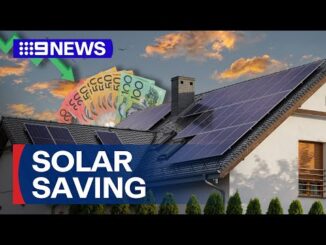
Let’s find out if a small power station or solar generator setup can save you money on your electric bill!
☀️ SOLAR CALCULATOR – estimate savings for your home, get free quotes from local solar companies
📈 SPREADSHEET
🛒 PRODUCTS used in this video
• EcoFlow Delta 3 Plus –
• Renogy 200W Solar Panel – (a good option but a cheaper alternative would be two 100W panels)
• Solar extension cable – (again, a good option but not the cheapest)
• XT60i adapter cable –
• Govee Smart Plug –
🔢 MY FREE SOLAR TOOLS
• Solar Panel Tilt Angle Calculator ➔
• Solar Panel Azimuth Angle Calculator ➔
• Peak Sun Hours Calculator ➔
👋 CONNECT WITH FOOTPRINT HERO!
• Blog ➔
• TikTok ➔
• Instagram ➔
Note: This video is not sponsored. I purchased all the solar equipment shown in this video with my own money.
~
This solar setup relies heavily on 2 overlooked features available in some EcoFlow power stations, such as the EcoFlow Delta 3 Plus: TOU (Time-of-Use) mode and Self-powered mode. (Two other EcoFlow power stations I own, the River 2 and River 3, have a variation of these features called “Energy management” and “Backup reserve” respectively.)
Using a solar generator setup to lower your electric bill doesn’t seem to be a popular use case, but I figured I’d give it a shot since power stations and solar generators are oftentimes sitting around collecting dust when they’re not being used for backup power or power on-the-go. And EcoFlow does market their TOU and Self-powered modes as being good for this sort of thing, after all.
The appliances I powered weren’t optimal in terms of energy usage. Some of you may be able to use a setup like this to run appliances that use 2-3x the energy on a daily basis, and therefore offset with solar — or shift the pricing period of — 2-3x the energy that I was able to. If you’re doing this sort of thing with your power station / solar generator, I’d be curious to hear what sort of savings you’re seeing!
~
Editor: Javan Khabi
Music:
– License code: 9ZCIUEK6HJQC3PD0
~
DISCLAIMERS
Some of the links in this video description and in the comments below are affiliate links. If you make a purchase after clicking on one, I may earn a commission which will help fund more videos like this one. Thank you! 🙏
For general informational purposes only. Nothing in this video is intended to be professional solar or electrical advice. Please consult with a licensed professional in their field of expertise in your jurisdiction.
As an Amazon Associate I earn from qualifying purchases.



It would be annoying as hell if it was just constantly fliping on and off to maintain it at a perfect 75%.
I sometimes have similar issues with my Kasa smart home app. I have it setup so that it turns on my driveway and garage lights if I get into a certain area near my house after sunset. I would say it works 75% of the time, but once in a while I have to open the app and then the lights kick on.
I really wonder if its an iphone thing more than a Kasa or Ecoflow thing.
Wouldn’t it be better to charge the system to 100% at the lowest or cheapest time. Then use the majority of that power to run your stuff and not use that management system because your constantly using energy from the grid which the whole point of solar is to not use energy from the grid so let’s say it takes you an hour to charge up your device to 100%. How much time could you get doing normal things your computer watching TV however you use it before it would get down to say 25% or you would have to recharge it again wouldn’t you save more money doing it that way then having it constantly topping off with the grid before it’s getting down to a low percentage?
Coming from a full-time van lifer with a solar setup and similar power station, you can run your stove, a gaming laptop, all your lights, a hot water heater, a diesel heater in the winter, a coffee maker, and more… And you will not run out of power. Depending on how you live, yes, one solar panel is enough to sustain your living situation indefinitely. Houses are different though, depending on your provider, flat fees, things like delivery fees, you won’t notice too much of a difference in your electric bill, but it will be there. Where I live most of my time half of the bill is in these flat fees. If you’re able to get off of the grid completely, which you can do for less money than you would expect, you’re not only saving money, you’re not spending any and you have reliable electricity.
Well, I think the biggest portion of everyone’s electric bill is for HVAC. That alone probably covers more than 70% of your bill (though this also depends on the size of your house), so unless you use a couple of tens of KWH, your bill will seem unaffected.